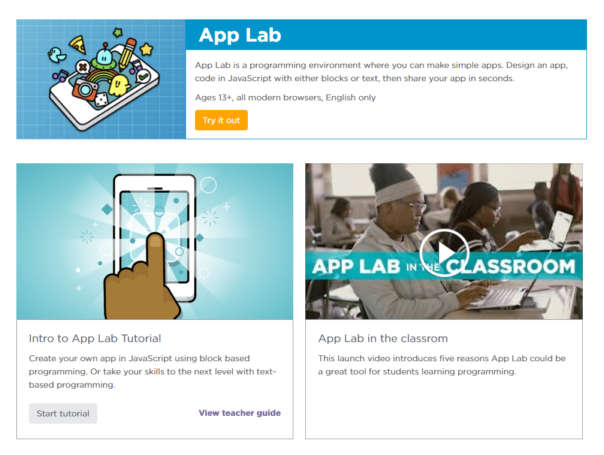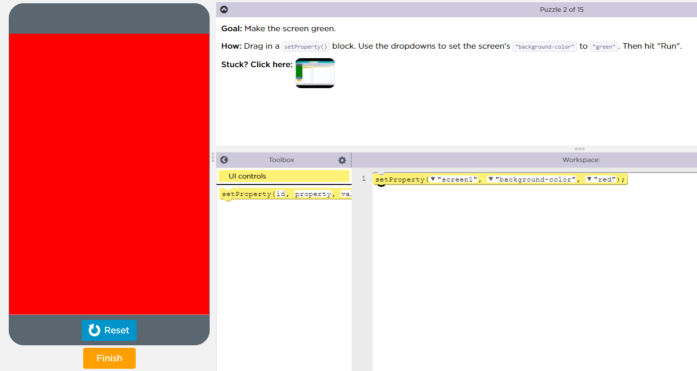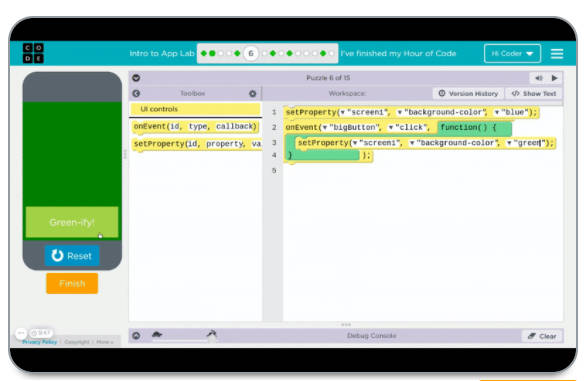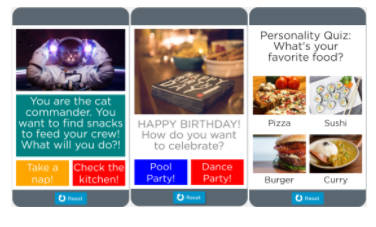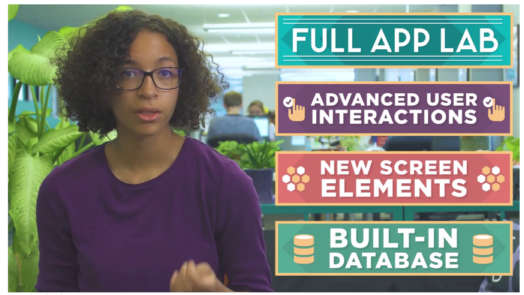| Hour of Code 2017 Introduces App Lab |
| Written by Nikos Vaggalis | |||
| Friday, 01 December 2017 | |||
|
It's the time of year when the world-class Hour of Code once more commences; just an hour for introducing coding to the uninitiated, having them complete self guided tutorials. But is a hour sufficient? What can a beginner actually code within this limit? The answer is a bit more complicated than that, so let's find out all about it! Integrated into the larger, worldwide, annual Computer Science Education week, this year taking place December 4-10, Hour of Code's novel mission has always been to get everybody coding, aged from 4 to 104, by providing: "a one-hour introduction to computer science, designed to demystify code, showing that anybody can learn the basics, and broadening participation in the field of computer science". But first of all, why this obsession with Computer Science, in particular in getting kids as young as 4 to learn to code? The answer is simple. Nowadays code is everywhere around us, from desktop computers to mobile phones and, thanks to with IoT, encompassing refrigerators and TV sets through to software driven cars and robots. As someone has to write code for controlling all those things, it's pretty obvious to assume that those with a solid background in coding will enjoy much better career opportunities than those one without. Skills in coding are destined to be even more sought after as soon as AI firmly establishes itself and gets widely commercialized.The first glimpses of the dawn of this coming age have already began to emerge in watching the big name corporations the likes of Google and Microsoft, snatching PhD students who work in the field of AI, or even remotely related disciplines, from their Universities to the point of having triggered a higher education crisis - see Increase In Uptake of Computer Science Challenges Universities Who's going to program all those devices and robots? As long as AI doesn't displace coders as well, something not foreseeable in the very near future at least, demand in them is certain to be sky high.
Hour of Code tries to spread this kind of excitement to the widest audience possible, by empowering anyone who wants to, to register and set up such an event and publicize it on the Hour of Code website in order to make it available to anyone regardless race, sex, age or state.The next step after securing a venue and equipping it with computers, be it desktops, laptops or tablets, (that's why a school classroom is the most likely place to host it) is to get hold of one of the many Hour of Code tutorials available online, which include Minecraft, Star Wars and Frozen. It has to be noted that the tutorials can be found translated in a multitude of languages, something that once more highlights the event's worldwide reach. The activities themselves are self guided so that students can learn at their own pace, although there's always assistance at hand from the organizers, who most probably are teachers themselves, who will supervise, assist and coordinate so that anyone can make progress. Content-wise, most of the tutorials teach code through dragging and dropping blocks ala Scratch fashion, but due to popular demand for tutorials that teach “real” coding in a professional language used by real-world programmers, this year a new tutorial called App Lab has been introduced with the aim of teaching JavaScript to middle and high level schoolers. App Lab teaches students to manipulate GUIs by creating and controlling buttons, text, images, sounds, and screens in JavaScript. The tutorial is split in five milestones, each one signalling the beginning of a brand new topic.
So Levels 1-4 of Milestone 1, involve manipulating the font size and background color properties of a simple mobile phone screen mockup by tweaking its setProperty() block and modifying it through its pull down options.Alternatively, you can use the option "Show Text" to type the code. This is a similar approach to that adopted by CodeMonkey, where you control your character by clicking on items or typing CofeeScript. Such a mixed block/text approach is suitable for total beginners since they are not forced to know the syntax or the functions needed beforehand, while the immediate visualization of the effect of fiddling with the GUI's properties is ultra rewarding, something that motivates the students to go on.
Levels 5-7, 'Make It Interactive' introduce Events through the onEvent() block, while Level 8-9 bring Images and Sounds into the mix. In levels 10-13, or milestone 'Design Mode', students learn to add screen elements themselves such as a new button that says "Right!" with an "id" of "rightButton".Finally, in 'Share Your App' - Levels 14-15, students get to build their own app by extending one of the boilerplate projects and then share it with the world or even send it to their mobile phone.These boilerplate projects, "Choose Your Own Adventure App", "Greeting Card" and Personality Quiz apps, can be extended by imagination, for example making an adventure about one's favorite character, tell the story of your favorite movie, create a thank you card for someone you appreciate, make a quiz that suggests something a person might like, or even "predict the future" based on the players' answers.In the penultimate gamification attempt of this learning experience, teachers can even print their students' Certificates of Completion so that they can celebrate their achievement.
That's the tip of the iceberg though, as this mere one hour of code acts as the gateway to even greater events the likes of Computer Science Education week, even more coding by signing up for the full version of the App Lab (on code.org/applab), or longer standing training by taking one of the recommended Code.org online courses, CS Principles, CS Discoveries and CS Fundamentals.
So if you know of someone aged between 4 and 104 who would benefit from learning to code, the best you can do is to introduce them to their nearest Hour of Code venue in the coming week.The act by itself will suffice in igniting the Computer Science spark inside of them...
More InformationRelated ArticlesIncrease In Uptake of Computer Science Challenges Universities Pythonroom Brings Coding to the Classroom President Obama Experiences An Hour of Code
To be informed about new articles on I Programmer, sign up for our weekly newsletter, subscribe to the RSS feed and follow us on Twitter, Facebook or Linkedin.
Comments
or email your comment to: comments@i-programmer.info
|
|||
| Last Updated ( Friday, 01 December 2017 ) |
